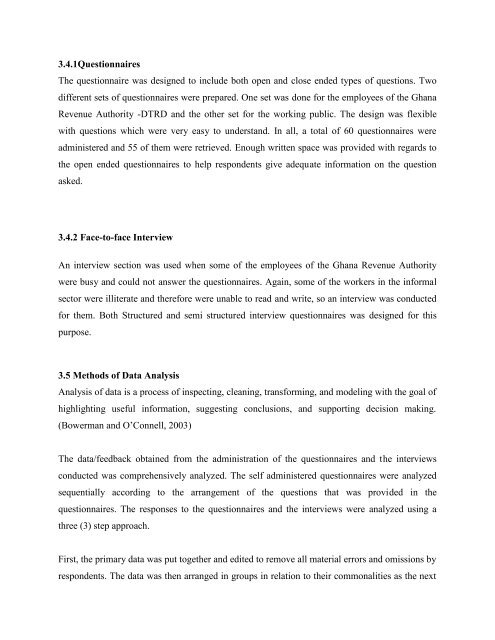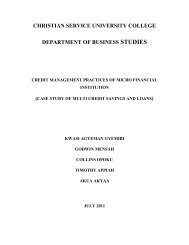TAX EVASION.pdf - Christian Service University College
TAX EVASION.pdf - Christian Service University College
TAX EVASION.pdf - Christian Service University College
Create successful ePaper yourself
Turn your PDF publications into a flip-book with our unique Google optimized e-Paper software.
3.4.1Questionnaires<br />
The questionnaire was designed to include both open and close ended types of questions. Two<br />
different sets of questionnaires were prepared. One set was done for the employees of the Ghana<br />
Revenue Authority -DTRD and the other set for the working public. The design was flexible<br />
with questions which were very easy to understand. In all, a total of 60 questionnaires were<br />
administered and 55 of them were retrieved. Enough written space was provided with regards to<br />
the open ended questionnaires to help respondents give adequate information on the question<br />
asked.<br />
3.4.2 Face-to-face Interview<br />
An interview section was used when some of the employees of the Ghana Revenue Authority<br />
were busy and could not answer the questionnaires. Again, some of the workers in the informal<br />
sector were illiterate and therefore were unable to read and write, so an interview was conducted<br />
for them. Both Structured and semi structured interview questionnaires was designed for this<br />
purpose.<br />
3.5 Methods of Data Analysis<br />
Analysis of data is a process of inspecting, cleaning, transforming, and modeling with the goal of<br />
highlighting useful information, suggesting conclusions, and supporting decision making.<br />
(Bowerman and O’Connell, 2003)<br />
The data/feedback obtained from the administration of the questionnaires and the interviews<br />
conducted was comprehensively analyzed. The self administered questionnaires were analyzed<br />
sequentially according to the arrangement of the questions that was provided in the<br />
questionnaires. The responses to the questionnaires and the interviews were analyzed using a<br />
three (3) step approach.<br />
First, the primary data was put together and edited to remove all material errors and omissions by<br />
respondents. The data was then arranged in groups in relation to their commonalities as the next



